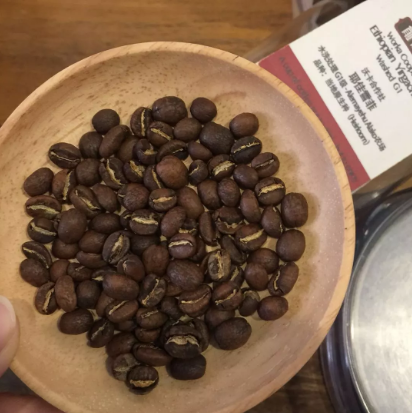Hand brewed coffee | Coffee beans with different dates have different hand brewing parameters.
Many friends should have had the same trouble with me when they came into contact with boutique coffee, so many varieties would like to try, how should the beans be brewed?
First of all, let's take a look at what the bean bag provides us with cooking information, take a chestnut:
Baking date: bean baking time
Some people claim that coffee only takes 24 hours to grow beans, and the third day is the peak of flavor, but this time is not enough.
I would advise customers to choose coffee beans that are roasted for 4-7 days, which are also defined as fresh coffee beans.
Sometimes when I go to a coffee shop to buy beans, I will listen to the clerk remind me that the beans have just been roasted and suggested to drink them after a few days. This time is the so-called bean cultivation period. Freshly roasted coffee beans emit carbon dioxide and create atmospheric pressure in the bag, which helps to integrate aromas with oils, making the aromas in the beans easy to extract. The shallower the degree of baking, the less obvious the exhaust, the longer the period of bean cultivation, and the deeper the degree of baking, the faster the exhaust effect, the shorter the period of bean cultivation.
The recommended cultivation period for very shallow beans is 5-7 days, and that for medium-deep baked beans is 3-5 days, which can be adjusted according to the suggestion. It should be noted that the best taste period for coffee is generally about 15 days, so it is better to drink the beans as soon as possible.
For example:
Yejia Xuefei
This Yega belongs to a shallow baked bean. How should it be brewed on different dates?

We can increase the temperature of the boiling water or adjust the grinding degree to improve the extraction rate.
The 4th day of soybean culture period: V60 filter cup, 15g powder, water temperature 90 degrees, grinding 3.5.The ratio of water to powder is close to 1:16.
35 grams of water steaming, steaming time is 35s
Segment: water injection to 110ml cut off, slow water injection to 230ml
The 15th day of soybean culture period: V60 filter cup, 15g powder, water temperature 87-88 degrees, grinding 4, the ratio of water to powder is close to 1:15
Steaming in 30 grams of water for 28-30s
Segment: water injection to 110ml cut off, slow water injection to 230ml
Manning
This Mantenin belongs to medium-deep baked beans. How to brew them on different dates?

The third day of soybean culture period: KONO filter cup, 15g powder, water temperature 88 degrees, grinding 4 (small Fuji), the ratio of water to powder is close to 1:16
Steaming in 30 grams of water for 30 seconds
Segment: water injection to 150ml cut off, slow water injection to 230ml
The 15th day of soybean culture period: KONO filter cup, 15g powder, water temperature 85 degrees, grinding 4.5 (small Fuji), the ratio of water to powder is close to 1:16
Steaming in 30 grams of water for 25 seconds
After stewing, slowly pour water into 230ml at one time.
Suggestion
Suggestion: deep-roasted coffee beans are suitable for 80-88 degrees water temperature, and medium and shallow roasted coffee beans are suitable for about 90 degrees water temperature. If the coffee beans have missed the best taste period and the flavor is greatly reduced, we can also remedy it by increasing the temperature of the boiling water and fine grinding or increasing the amount of powder.
Important Notice :
前街咖啡 FrontStreet Coffee has moved to new addredd:
FrontStreet Coffee Address: 315,Donghua East Road,GuangZhou
Tel:020 38364473
- Prev

What happens when you drink too much coffee? The silent effects of caffeine on our bodies and minds
Professional barista communication Please pay attention to coffee workshop (Weixin Official Accounts cafe_style) We will introduce various symptoms caused by excessive intake of caffeine such as coffee and tea, and the impact of caffeine addiction on the spirit. About Caffeine Addiction Caffeine addiction is poisoning caused by caffeine. Caffeine has a mild stimulating effect on heart function and is said to be consumed in high amounts.
- Next

Water | effect of different water quality on the taste of coffee
As we all know, the water used for brewing has to be filtered by carbon and has no peculiar smell, but this is only the basic requirement of high-quality brewing water. In order to get better coffee (or tea, Espresso), the water used should be neutral pH, with a certain hardness, alkali content, and total dissolved solid content (TDS). The following are hydrochemical terms related to coffee making. Total dissolution
Related
- Beginners will see the "Coffee pull flower" guide!
- What is the difference between ice blog purified milk and ordinary milk coffee?
- Why is the Philippines the largest producer of crops in Liberia?
- For coffee extraction, should the fine powder be retained?
- How does extracted espresso fill pressed powder? How much strength does it take to press the powder?
- How to make jasmine cold extract coffee? Is the jasmine + latte good?
- Will this little toy really make the coffee taste better? How does Lily Drip affect coffee extraction?
- Will the action of slapping the filter cup also affect coffee extraction?
- What's the difference between powder-to-water ratio and powder-to-liquid ratio?
- What is the Ethiopian local species? What does it have to do with Heirloom native species?

